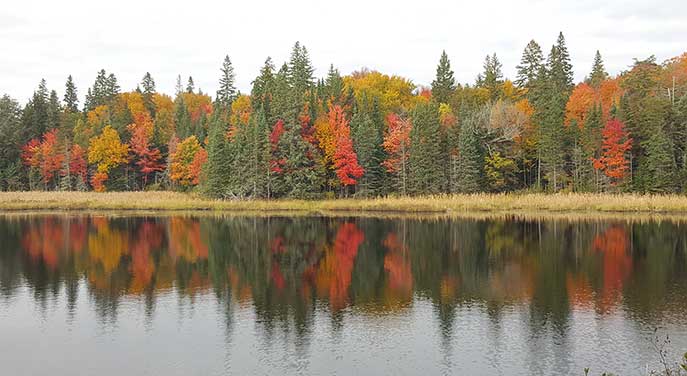 Autumn is a time of reflection. I love the fall as it is both a time of awe-inspiring colours and a foreboding of winter soon to come … but the former somehow overshadows the latter for me.
Autumn is a time of reflection. I love the fall as it is both a time of awe-inspiring colours and a foreboding of winter soon to come … but the former somehow overshadows the latter for me.
We are fortunate to live in a part of the world where our four seasons are distinct and where vast tracts of natural foliage persist for us to see and admire vistas of colour in September and October. Everywhere hues of orange, red, purple, yellow and brown intermingle with shades of green.
Although this is an expected annual event, we still watch in wonder as the trees change colour and the leaves eventually fall.
But what is really going on here?
Let’s explore this a bit. Plants are full of water, a medium critical to the trees’ survival as fluids carry food through the plant and help them flush waste. Water freezes in winter, so food and water transport become impossible as the veins in the plants become clogged with ice crystals – a bit simplistic, but this captures the essence of why it’s better not to try to make food during winter if you’re a tree.
So how do summer’s green leaves change colour? Well, surprisingly, they don’t!
The fall colours are there all the time but are masked by chlorophyll, the green pigment most plants have that is used to produce their food. In the fall, chlorophyll production gradually declines and eventually stops entirely.
 |
| Related Stories |
| What to do when you see wildlife on urban trails
|
| What the heck are jumping worms?
|
| Seasons come and go, but where did they get their names?
|
At this point, the green colour of the leaves fades, and the underlying colours emerge. Shades of red, orange and yellow predominate and are derived from different pigments. Carotenoids produce the orange, xanthophyll the yellow and tannins the brown colours, while anthocyanins produce the reds and purples.
Interesting, but why are some trees red, others brown and still others yellow or orange? It’s not really clear, but it may have something to do with the type and quantity of sugars produced in the leaves or how much pigment and in what combination it exists in the leaves in the fall. Suffice to say, it is complicated but the outcome is clearly gorgeous, whatever the reason.
The lengthening nights seem to be the overriding factor that stimulates trees to change colour, but other factors come into play. The intensity of the colours that develop in any particular year is related to weather conditions that occur before and during the time the chlorophyll in the leaves is declining, with temperature and moisture the main influences.
A succession of warm, sunny days and cool, crisp (but not freezing) nights seems to bring about the most spectacular displays. Under these conditions, high volumes of sugars are produced in the leaves, but the gradual closing of the veins in the leaves traps these sugars in the leaf cells. These conditions encourage the production of anthocyanin, which tints the leaves with the more brilliant red, crimson and bright orange colours overshadowing the greens of summer.
In conditions where we don’t have sunny days mixed with cool nights, the anthocyanins are not produced at the same rate, colours are more subdued, and the yellows and browns dominate. Hopefully, this fall is one of those spectacular autumns where the colours are intense and unforgettable!
But why don’t evergreens (conifers) lose their leaves (needles)? They do – just not in the same way deciduous trees do. Essentially, conifers’ leaves are tougher than their deciduous cousins and often have a waxy surface that allows them to continue to function throughout the year and not become damaged by freezing and thawing during the long dormant periods of winter.
Most do lose their leaves but gradually over a prolonged period of months or years. Some species like the White Pine drop masses of needles in the fall, usually from the inner branches, while others, like the Larch (Tamarack), lose all their needles in the fall and go dormant like the deciduous trees. Natural processes are complicated but fascinating, as you can see.
So as we bid farewell to summer’s beauty, let’s welcome the spectacle of the fall colours!
Geoff Carpentier is a published author, expedition guide and environmental consultant. Visit Geoff on LinkedIn, Instagram and Facebook.
For interview requests, click here.
The opinions expressed by our columnists and contributors are theirs alone and do not inherently or expressly reflect the views of our publication.
© Troy Media
Troy Media is an editorial content provider to media outlets and its own hosted community news outlets across Canada.

